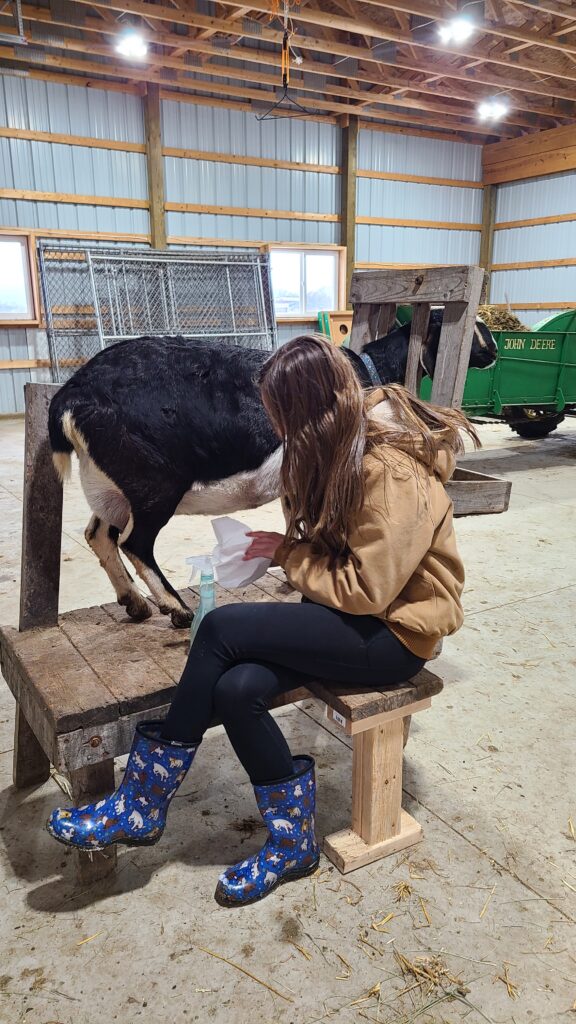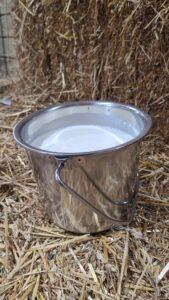With proper training, milking can be an enjoyable experience for both you and your goat. Here are some tips to get your goat used to being in the stanchion, handled, and milked with minimal stress.

This post contains affiliate links. As an Amazon Associate, I earn from qualifying purchases.
Imagine a sweet, floppy-eared doe that comes when called, eagerly jumps onto the milking stand, and waits for her grain. She doesn’t kick or stomp. She quietly eats while you rest your head on her side and milk.
This might sound like a fairytale if you are used to pulling, pushing, and crying over spilled milk, but it can be your reality too. With time and patience, you can turn a first-freshener or unruly goat into a productive milking partner.
Here are a few training tips that I use with new goats or first-timers to get them accustomed to the milking program. These can be applied whether you’re hand milking or machine milking.
1. Start Training the Milk Goat Early
Don’t wait until your goat is engorged and leaking milk to begin the training process!
The first thing that I teach a potential milker is how to use the milk stand and they learn this before they are even breeding age. Once a goat on my farm is big enough to be secured in the milking stanchion, I use it for regular hoof trimming and vaccinations.
To train them to jump up on the stand, I first pick up the goat’s front feet and put them on the stand. Then I lift their back legs. Then I direct their nose through the head gate and secure it.
For safety, you want to make sure you stay near a goat that isn’t used to being up on a stanchion or having its head locked in. An inexperienced goat can get frightened when it figures out its head is caught and may step off the stand, potentially injuring itself.
Goats are smart! After a few repetitions of helping and guiding the goat onto the stand and into the head gate they will learn how to do it themselves. A treat every so often helps reinforce the behavior. I only intermittently reward my animals so they don’t expect it every time.
2. Feed the Milk Goat on the Stand
I feed my does their ration of grain while I am milking. For a doe in training, I start feeding her on the milk stand a few weeks before she kids. She learns that when she jumps up and puts her head through the gate that she will get her meal, so she does so willingly.
For a new milk goat, the feed is a good distraction from the milking process. It gives her something to do while I am milking so she is less likely to be irritated and stomp and kick.
I recommend only feeding their set ration. When she runs out and starts getting fidgety, I don’t add more to appease her.
3. Desensitize the Milk Goat
This step is very important so that you have a calm animal that you can work with. I start the desensitization process when I start feeding a pregnant doe on the milk stand, several weeks before she kids.
While she is eating her grain, I go through some of the milking steps like cleaning the udder so that she gets used to being touched. I use a spray bottle with my homemade teat and udder wash, for the recipe click here!
I clean the udder and teats and then dry with paper towel. If she jumps or kicks, I just keep doing it so that she learns that she can’t get away or that I won’t stop with those types of responses. It shouldn’t take too many repetitions for your doe to get used to you manipulating the udder. You can even bump the udder and squeeze the teats so that she gets used to those sensations.
If your goat is very touchy, you might want to start with a less sensitive part of her body and brush or pet her until she settles down and then work your way to the udder.
4. Be Patient with the Milk Goat
When working with animals, it is helpful to stay calm yourself and work slowly. Don’t set too high of expectations for the goat the first time. Being patient and planning for several weeks of practice before things go smoothly is realistic and will help you both not get too frustrated.
Realizing that, like us, animals have bad days and even a seasoned milk goat can act up once in a while is important.
If your goat is acting up, check to see if there is an underlying cause. Maybe there are flies biting her while you are milking and that is why she is stomping. Or perhaps if you are milk-sharing with kids, she has a sore from her kid’s sharp tooth and that’s why she’s sensitive. Take the time to assess your doe if there are changes in her usual behavior. Milking is a great opportunity to note body condition and any signs of disease or injury.
5. Use Positive Reinforcement with the Milk Goat
You want the milking experience to be positive for you and the animal. I like to end the encounter on a positive note, even if it was rough. Rewarding the doe with a treat or a pat when you put her away helps convey that she was good that she is appreciated.
Negative reinforcement, or punishment, doesn’t work as well with animals from my experience. Inflicting pain, like hitting the goat when she stomps or kicks does not help you establish trust or make her want to get milked again.
I don’t use hobbles or tie downs on my does that stomp, the only restraint I use for the milk goat is the head gate of the stanchion. For an especially stompy doe, what I do is lean into her a little bit while milking. The extra weight makes her plant her feet for balance, so she can’t pick one up and put it into your clean milk bucket!
6. Don’t Reward the Milk Goat’s Bad Behavior
You can train the milk goat, or the milk goat will train you. If you stop milking when she stomps or kicks, she learns that she can get her way. Instead, try and move with her and be persistent when she acts up. Ignoring the bad behavior and continuing to do what you need to do is the best way to make her stop.
If she eats faster than you can milk, don’t add more grain. Doing so teaches her that if she jumps around and acts up that she will get a treat. Instead, ignore the behavior and work efficiently. She will eventually learn patience and that she is done when you are done, and only then.
My other recommendations for dealing with a fast eater are to wait to feed the doe until you have cleaned the udder and are ready to milk. You can also spread the food out so it takes longer to consume.

It takes time to train a goat to be milked, but once you have them trained you have a milking partner for years to come. Milking is one of the chores that I really look forward to everyday and I hope that these tips are of value to you.
Do you have other tricks that you have found helpful in training a milk goat? I would love to hear about them in the comments below!

Mother, farmer, author, and teacher by trade… She loves tending to things and watching them grow!
